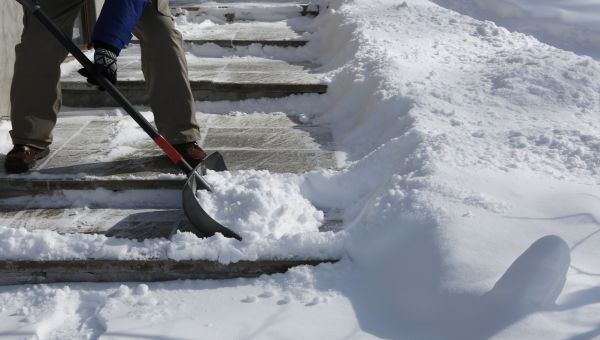6 ways to stay pain free this winter
Ease irritated joints and avoid cold-weather injuries with these expert-approved tips.
Updated on July 23, 2024

Winter wind can chill you to the bone, aggravating pain from chronic conditions and causing old injuries to flare up again. Here are six ways to avoid winter injuries and stay pain-free when the temperature drops.

Try water aerobics
Water aerobics offers more of a workout than you might think: Just being in the water provides you with 12 times the resistance you have on land. That combination of cardio and resistance training forces you to work harder and allows you to burn more calories.
On top of those benefits, water aerobics can be an important treatment for people with chronic pain conditions like fibromyalgia and arthritis, says Stephen Gelfand, MD, a rheumatologist in Myrtle Beach, South Carolina. “You have the advantage of buoyancy, which allows you to move your joints without the impact you would normally feel on land,” Dr. Gelfand explains. That movement, plus the warm water, eases pain and stiffness.

Drop the snow shovel
Shoveling sends more than 11,000 Americans to the emergency room each winter. The intense physical activity, combined with the frigid air and slippery ground can be a recipe for:
- Heart attacks
- Deadly falls
- Back, shoulder, and chest pain due to strained muscles
Think of it like this: If you feel aches and pains after a steady, controlled gym session, you’re bound to feel pretty awful after moving piles of heavy snow with poor posture—about two thousand pounds per 15 minutes with a standard shovel. If you have a heart condition or chronic pain, put the shovel down and talk to your HCP. If you’re a healthy adult, follow these safety tips, wear water-resistant boots, and dress in layers.

Leave the flask at home
Normally, when you step into the cold, blood rushes away from the surface of your body, towards your internal organs. Warm, oxygen-rich blood keeps your heart, brain and lungs working their best until you can find shelter.
But alcohol makes your body do just the opposite—it causes blood to rush towards your skin, lowering your core temperature. It also keeps your body from shivering, which is a key part of how you stay warm.
Plus, alcohol lowers your inhibitions, says Gelfand. That puts you at risk for painful falls and injuries that could leave you hurting all winter.

Stay hydrated
Drinking water makes you urinate more often—but if you eliminate fluids faster than you take them in, you can become dehydrated. In the winter, your body naturally loses more fluids to begin with: To humidify the cold, dry air, your lungs need to release more moisture as you breathe.
If you’re dehydrated, your body will send the fluids you do have to essential organs like your heart and brain, instead of your fingers and toes. For people with poor circulation from conditions like diabetes and Raynaud’s disease, that lack of blood flow can worsen hand and foot pain, warns Gelfand.

Keep your vitamin D levels up
Vitamin D is created when sunlight reaches your skin. If you’re staying indoors and bundling up from head-to-toe when you go outside, your vitamin D stores can plummet during the winter.
But you need vitamin D to absorb calcium, which supports strong, healthy bones. If you have deep bone and muscle aches in the winter, get your vitamin D level checked. A low level can cause:
- Bone pain, fractures
- Exhaustion
- Muscle aches
Consider adding these foods rich in vitamin D to your diet:
- Fatty fish like salmon, trout, tuna, and sardines
- Mushrooms
- Eggs
- Cheese
- Foods fortified with vitamin D, like orange juice and yogurt
Talk to an HCP before using supplements.

Try heat therapy
Heat therapy, which includes saunas, wraps, and heating pads can ease a variety of winter pains. The warmth relaxes tight muscles and encourages blood flow to injuries, which speeds up the healing process.
People with Raynaud’s disease—who have worse pain in their hands during the winter due to poor circulation—should carry hand warmers in their pockets. Also, avoid handling ice and when working in the kitchen, don’t place your hands in the refrigerator for more than a few seconds, says Gelfand.
For winter back pain, relaxing in a sauna or steam room can be helpful. Just be aware that the dry heat in saunas is dehydrating, so drink plenty of water to replace your fluids.

Cleveland Clinic. Just Keep Swimming: 9 Health Benefits of Water Workouts. August 15, 2023.
British Heart Foundation. Heart Matters: Take the Plunge. Accessed July 22, 2024.
Arthritis.org. In the Swim: Aquatic Exercise for Arthritis. August 15, 2022.
Bidonde J, Busch AJ, Webber SC, Schachter CL, et al. Aquatic exercise training for fibromyalgia. Cochrane Database Syst Rev. 2014 Oct 28;2014(10):CD011336.
CCOHS.ca. Ergonomics: Shovelling – Snow. May 10, 2024.
Nationwide Children’s. Snow Shoveling. Accessed July 22, 2024.
Yuan K, Haddad Y, Law R, Shakya I, et al. Emergency Department Visits for Alcohol-Associated Falls Among Older Adults in the United States, 2011 to 2020. Ann Emerg Med. 2023 Dec;82(6):666-677.
Drinkaware (UK). Alcohol and cold weather. Reviewed March 8, 2021.
Massachusetts General Hospital. The Importance of Winter Hydration. December 2, 2022.
NIH: Office of Dietary Supplements. Vitamin D. Updated September 18, 2023.
More On


video

article

slideshow


video


video
